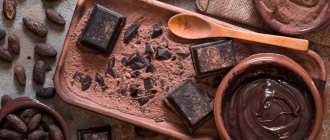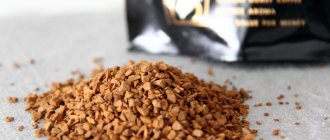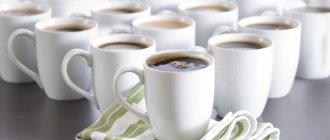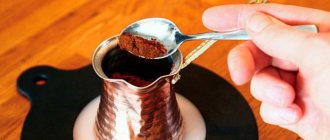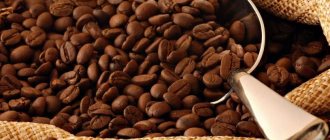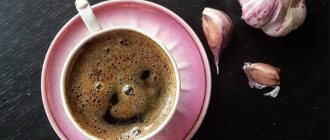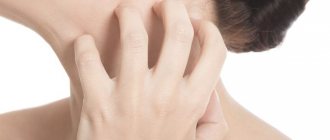The amount of caffeine in tea: what it depends on
Not only are alkaloids present in coffee blends, but natural tea leaves also contain them. The percentage of substrate they contain depends on many factors, such as variety, quality, preparation method and brewing time. The level of saturation ranges from negligible to quite impressive.
To a large extent, this depends on how selected the raw materials are chosen when manufacturing the product. The highest percentage falls on the top leaves, and as it decreases, the concentration of invigorating elements also decreases. On the lowest growing shoots there is less than 1%. You can easily recognize a good product on a store shelf - products made from tall-growing leaves are much more expensive than their analogues. For example, in “An Ji Bai Tea”, consisting only of the top leaves and buds, the caffeine content will be much higher than, for example, in the usual “Gunpowder”. So-called decaf teas are produced using the outermost leaves. It is worth noting that they also have their own percentage, although very small.
To understand whether tea or coffee has more caffeine, you need to know how the raw materials are processed. The fewer processing cycles it goes through, the better the product retains vitamins and other components, and the more intensely the elements that stimulate the nervous system are released. Based on this, we can conclude that the most saturated are green varieties, because they are the least processed. One serving can contain between 50 and 80 milligrams, which is almost more significant than the black varieties. These data show that green does not always mean a less dangerous and healthier product.
How much caffeine is in a cup of coffee
Ground is different from granular, which contains a different amount of active ingredient compared to the freeze-dried product.
By adding various components the amount of caffeine is reduced
Ground coffee
A mug of freshly brewed liquid contains from 70 to 140 mg of the component. Varieties of popular coffee with substance concentration per 170 mg of finished drink:
- Ethiopian “Mocha” – 160;
- "Peru" - 170;
- "Mexican" - 170;
- "Santos" - 160;
- "Cameroon" - 180;
- "Salvador" - 187;
- "Cuban" - 195;
- "Robusta" from Congo - 325.
Robusta grains contain a maximum amount of 170 to 200 mg. Arabica contains the smallest dosage - 40-60 mg. In any case, there is more caffeine in ground coffee than in other varieties.
Instant coffee
The drink is divided into three types:
- Powder is affordable. The mass is extracted from finely ground grains, which are thoroughly fried under high pressure. The extract is dried, the powder is packaged and sent to retail outlets.
- Granular is obtained using a technology similar to the previous type, but some features stand out. When processed with steam, granules are formed from the powder, which acquire a special taste and aroma.
- Freeze-dried stands out significantly among the other two types. The coffee beans are frozen and then vacuum dried. Next it is crushed.
The sublimated liquid retains all the positive properties of the grains, taste and smell. It differs from granular and powder products in its preparation technology, which does not spoil the quality of the drink. Freeze-dried liquid contains the same amount of caffeine as natural liquid. A person who does not suffer from heart disease or gastrointestinal pathologies is recommended to drink no more than 2 cups of freeze-dried product per day. Powdered and granulated are allowed to consume no more than 5 cups.
Different brands have their own, sometimes different, substance content. The permissible level of alkaloid should not fall below 2.8%. How many milligrams of caffeine are in instant coffee:
- Café Pele – 3.8%;
- Nescafe Classic – 4.2%;
- Jacobs Monarch - 3.3%;
- Black Card Gold - 4.2%.
People often wonder how much caffeine is in a teaspoon of instant coffee? One full spoonful of tea leaves contains approximately 80 mg of the substance.
Decaffeinated coffee
Some consumers naively believe that coffee labeled as decaffeinated actually lacks this component. This is not entirely true - it can contain an alkaloid of 7 mg in a large mug and over 3 mg in a small cup .
Tea contains some caffeine
Cooking method also matters
Regardless of the grade, the level of caffeine alkaloid can be increased or decreased by brewing technique. It is released much more strongly from the mixture when high-temperature water is used. If you use a liquid that is not too hot, most of it is retained in the sheets. But this only works with green varieties; black cannot be cooked without boiling water, so it turns out more rich.
Concentration is of great importance: the more poured into the cup, the higher the level of active elements. The optimal amount for green is 4-7 grams per serving, and for black it is half as much. Although a lot depends on the leaves, many popular brands have different percentages for the same volume. The strength will be much lower if the composition contains many flavors.
Which to choose
When choosing, experts recommend paying attention to several parameters that will help determine the concentration of theine:
- Composition of raw materials. The large leaf is inferior in number to the young leaves and buds.
- Processing method. In weakly fermented classes, its concentration is higher; prolonged fermentation leads to a decrease in the caffeine content in the total mass.
- Collection time. For lovers of tonic properties, spring assemblies are suitable.
- Climate, plantation location. Whether green tea contains more caffeine can be determined by knowing where it grew. In the mountains, the plant develops more slowly due to lower temperatures, so it accumulates it.
Useful data
Initially, it was believed that the leaves and grains contained various tonic substances. In the first, alkaloids-tannins were isolated, and in the second, a full-fledged alkaloid-caffeine. Active tannins were discovered in tea leaves back in the 19th century, and were classified as a separate species.
Only 100 years later, scientists came to the conclusion that this is the same coffee alkaloid. But the effect on the body was different, so studies were conducted to find the reason for this difference. It turned out that “coffee” human activity is shorter, but more intense than “tea” activity. The brewed grains have a short-term stimulating effect, while the leaves are tonic for a long period of time, and in addition remove thirst and refresh. Thanks to these properties, tea drinking traditions have been popular throughout the world for thousands of years.
Benefits of caffeine
If you consume caffeinated drinks correctly, it will have many positive effects on the human body.
- Morning awakening. Sometimes it is difficult to imagine and start your morning without a cup of coffee. A small dose of caffeine will help the body prepare for the day.
- Physical endurance. Research has shown that caffeine helps athletes improve endurance and strength. Accordingly, training becomes more effective, performance increases when performing strength loads and in fitness.
- Improved brain activity. In addition to its effects on physical performance, caffeine also helps the brain think more clearly. Infrequent use of caffeine in people with short-term memory and slow mental activity improved their performance.
Where is the concentration higher: in tea leaves or coffee beans
If you consciously and moderately consume caffeine-containing products, their effect on the body will be positive. The main problem is that their impact on each person can vary significantly, depending on the individual and the condition. For some, half a cup of cappuccino is enough to cheer them up; for others, even two stronger espressos will not feel the effect. Therefore, it is necessary to understand the actual content of the stimulating elements in each type.
Find out how much caffeine is in a cup of tea and coffee from the detailed table below:
| Name | Cup volume in ml. | Content in mg. | |
| Coffee | Ground | 250 | 100-200 |
| Soluble | 80-100 | ||
| Decaf | 3-5 | ||
| Tea | Black | 45 | |
| Green | 70 | ||
How much tea to drink per day
A safe dose for one dose is considered to be 100-200 mg of caffeine. The permissible daily amount of caffeine for a healthy person is 1000 mg maximum.
If we look at the study discussed at the beginning of the article, experts found that a cup of tea contains no more than 85 mg of caffeine. It turns out that it is permissible to drink up to 12 cups of tea per day without harm to health. But hardly anyone should worry about it.
This means that drinking 2-3 cups of tea a day will be beneficial for the body: no one has ever had a boost of energy during the day and a catalyst for the process of burning calories.
What drinks can be replaced
Ivan tea contains a minimal amount of alkaloids, but has a whole list of useful components. All of them have a beneficial effect on human health. The level of vitamins C and B in the mixture based on this plant is very high (even compared to oranges, lemon and other traditional sources). The composition also contains quickly digestible proteins, and the percentage of harmful acids (purine, uric, oxalic and others) is extremely low.
Other non-alkaloid herbal mixtures (based on linden and chamomile) also have beneficial properties, and their use has a positive effect on a person’s physical condition. You can prepare them yourself or purchase them at a pharmacy or specialty store. The search for alternative invigorating blends is simply necessary when the daily dose of consumption approaches the 1000 mark.
You can also highlight special products that are manufactured using the decaffeination procedure. These are ordinary mixtures with a minimum percentage of content. Some of the representatives of this line differ slightly in taste characteristics, and also have identical aroma and color. The cost and quality of a particular product will influence the product’s compliance with the classic options.
How to Consume Caffeine for Benefits Without Harm
If you enjoy caffeinated drinks but are wary of the negative effects, take note of the following information:
- Don't drink caffeinated drinks every day
This is a difficult task for those who are accustomed to a daily coffee ritual. But if you drink coffee every day, then limit yourself to at least one cup a day.
- Know your norm
If you like to drink coffee and other drinks containing caffeine, be careful not to overdo it. If you drink so much that you feel nervous, you are definitely over your limit. Or vice versa, if the effect of consuming caffeine does not occur, feel free to increase the dose.
- Find a caffeine alternative
Cocoa or raw chocolate contains a substance similar to caffeine. It has no effect on the nervous system. Instead, blood flow throughout the body is stimulated. The circulatory system delivers more nutrients to the brain. And you feel cheerful and energetic.
Caffeine is a natural substance found in tea and coffee, some of the most popular beverages in the United States. It does not have a bad reputation, but it is still addictive, like any stimulant. However, it does not cause the terrible side effects found with other stimulants. If you consume drinks containing caffeine wisely, its effects will only benefit the body.
It is important to know how much caffeine you drink every day with each cup of coffee. This is to ensure that you get only the benefits from caffeine, while minimizing the risk of developing any of the side effects we discussed above.
Remember, too much caffeine will harm you.
What effect does it have on the human body?
As we have already said, the concentration in the finished coffee product depends on the brewing time. The longer the extraction takes place, the higher the percentage of alkaloid elements extracted. A person uses this to stimulate the nervous system and gain new strength. In people under such influence, an increase in heart rate, constriction of blood vessels, and acceleration of the pulse are observed. But the beneficial effect cannot be separated from the side effects, so you need to monitor the dosage of consumption. Exceeding the recommended dose of 4 g can negatively affect the functioning of the heart muscle and other internal organs.
Peculiarities
A cup of espresso or cappuccino works almost instantly. The nervous system reacts after 2-3 minutes by accelerating the heart rate. The mood rises, brain activity is activated, and the desire to do something arises. Coffee effectively awakens you and improves your performance, but the result quickly wears off and you return to your original state.
The “tea” effect is different from the “coffee” effect. It is soft and unnoticeable, lasts several hours and goes away as smoothly as it appears. Tea does not contain pure caffeine, but is associated with tannin. They form theine, due to which the action is more delicate, there are no pressure surges and sudden changes in heart rate. It dilates blood vessels, improves the functioning of the nervous system and brain. Its advantages are that it:
- does not accumulate in the body;
- the dry leaf contains it in greater concentration than the infusion;
- is slowly absorbed into the blood and quickly excreted;
- gently stimulates the heart and central nervous system.
It is impossible to say unequivocally which type of tea will have more tonic substances - the different biochemical composition makes such a comparison simply impossible. According to the data, the amount of the energizing substance ranges from 30 to 100 mg per serving. You can estimate this value relative to other drinks in the table below.
| Name | mg caffeine per cup |
| Green tea | 30-100 |
| Ground coffee | 110-200 |
| Instant coffee | 60-173 |
| Espresso | 240-720 |
| Cappuccino | 2 |
| Black tea | 40-100 |
| Energetik | 70-80 |
Caffeine content in tea and coffee - comparison table
| Name | Serving (ml/g) | Average content (mg) | |||
| Coffee | Natural | 250 | 170 | ||
| Soluble | 100 | ||||
| Decaf | 5 | ||||
| Espresso | 30 | 50 | |||
| Tea | Black | 250 | 45 | ||
| White | 55 | ||||
| Green | 70 | ||||
| Energetik | 85 | ||||
| Chocolate (dark) | 100 | 40 | |||
| Chocolate ice cream | 35 | ||||
| Lemonades and soda | 330 | 35 | |||
| Iced tea in bottles | 20 | ||||
| Hot chocolate | 240 | 10 | |||
All figures indicated in this table are average values and may differ either up or down. This depends on the specific name, quality of the product and method of preparation (we wrote about all these nuances above). The range between the maximum and minimum value can be up to 50%.
Comparison of content in different varieties
Black
In this product, the amount of tannin alkaloids can reach 70 mg (average 45) per serving. In this parameter, it is almost 3 times inferior to brewed ground coffee. But it is worth considering the degree of concentration of the mixture in the cup, as well as the duration of brewing and grade, because the values may vary depending on these factors. Note that in addition to stimulating crystals, this form contains useful antioxidants that have a beneficial effect on the vital functions of the human body. In combination with them, the effect becomes softer and longer lasting.
Green
The average values of the richest representative of tea products are 15-25 percent higher than those of the black counterpart. According to these criteria, it can compete even with soluble species, but subject to certain conditions. To achieve the maximum invigorating effect, we recommend increasing the brewing time and using varieties without flavorings. Thus, the strength will be further increased.
White
There is a common myth that this variety does not contain alkaloids, and its content of beneficial antioxidants is higher than anywhere else. However, this is a misconception, because there are many white varieties in which the spread is very large. One cup can contain between 15 and 75 mg. Therefore, it is difficult to assign this variety a position in the list relative to its brothers. Nominally we place it between black and green, taking into account the average values.
Decaf
The name of this species is not entirely correct, because it still contains its own share of caffeine, although not as significant as in the classic subspecies. Modern methods of extracting alkaloids from a mixture do not allow one hundred percent to get rid of them. Therefore, one serving of 250 ml accounts for about 0.005 grams.
Standards for caffeine content and consumption
In addition to coffee beans and tea leaves, natural caffeine is found in cola leaves, cocoa beans and many nuts and fruits. In the modern food industry, synthetic caffeine has found its use in the production of tonic drinks and dishes, energy bars and other similar products. As for different types of tea, oddly enough, the most caffeine is found in green varieties. This is ensured by an incomplete fermentation cycle, which preserves almost the complete composition of the raw material. Green tea is produced by lightly withering and further drying, so the drink is as strong as coffee. In addition, the level of caffeine and its derivative compounds - alkaloids - is influenced by the type of tea, concentration and brewing time, as well as the strength of the drink.
You may be interested in: Tea acidity - pH indicator as an indicator of your health
Approximate caffeine content in different types of tea (per 100 ml):
- Black teas - from 20 to 35 mg.
- Green leaf tea - from 30 to 50 mg.
- White tea - from 6 to 25 mg.
- Oolong - from 15 to 55 mg.
In terms of caffeine content, green tea also contains tannin in the leaves and the finished drink. This substance partially blocks the effect of caffeine, so the invigorating effect of a cup of tea will be slightly lower compared to coffee. At the same time, the duration of action will be longer, which makes the tea a more invigorating morning drink.
The video will tell you more about the caffeine contained in different types of tea.
Natural coffe
Answering the question of how much caffeine is in a cup of green and black tea, we can say – less than in coffee drinks. It is a mistake to think that a high concentration of alkaloids is a sign of a good product. The best varieties have a lower percentage. For example, between mocha and robusta the difference in richness can be almost twofold. If we take the average values, then there will be 0.17 g in one serving. The safest (from a medical point of view) method of preparation is as follows:
- Take 20-30 grams of coffee.
- Pour 200-250 milliliters of boiling water.
- Heat until boiling.
The aroma and taste will not change, but the risk of obtaining increased concentrations is reduced. There will be an optimal dosage that will not harm your health.
Decaf Green Tea: Fiction or Truth
There are two known ways to neutralize the effects of caffeine. The first is considered less harmful because it occurs without the use of chemicals. CO2 – extraction or “fizzing”, done using carbon dioxide and water. The advantage of the procedure is that it retains more than 90% of beneficial polyphenols and antioxidants. Dry leaves are placed in a chamber with liquefied gas under pressure. After 10-12 hours, it is released, the gas evaporates, and the caffeine is filtered out. The taste of the product remains excellent after removing unwanted components. This justifies the high cost of the process.
The second option is to use a chemical solvent - ethyl acetate. The leaves are soaked in it for several hours, it draws out and dissolves the alkaloid. “Natural neutralization” has been used for a long time and is a budget alternative. Using it, manufacturers retain only 20-30% of useful components.
Any technology changes the taste of the finished drink; information about it must be contained on the label.
Decaffeination does not lead to absolute elimination of the psychostimulant. It simply becomes negligible. If you have an allergy to a component or an individual intolerance, choose “non-tea” infusions: berry, fruit or flower.
Soluble
In this case, everything depends on the specific manufacturer, brand and quality of the original raw materials. For this variety, inexpensive varieties are taken, and the grains themselves are selected smaller; substandard ones are often used. Different blends will also reduce the saturation, so for one cup of freeze-dried product the average will be 100 mg. But these figures contain an error factor, because on the market there are both very high-quality brands and outright imitation of natural products.
What affects the amount of caffeine
Among these factors, the first line is occupied by the grain variety. Next comes the following things:
- Roasting method;
- Grinding;
- Method of preparing and brewing grains.
All these factors will be discussed in more detail below.
Variety
There are four varieties:
- Arabica;
- Robusta;
- Liberica;
- Excels.
Most people in the world consume Robusta and Arabica. This is due to the fact that Liberica and Excelsa produce fairly strong grains that are almost unusable in the food industry.
You can also highlight certain manufacturing countries:
- Colombia;
- Guatemala;
- Costa Rica;
- Tanzania;
- Jamaica;
- Countries of the Arabian Peninsula;
- India.
These countries produce a very elite tonic drink; it costs more than Arabica and Robusta and has a stronger taste.
Per 100 grams of product, Arabica contains about 1000-1500 mU. enzyme, and in robusta it is about 1100-2500 mg.
Roasting
No less important than the variety is the method of roasting the beans. The type of roast has a very big impact on how much caffeine is in the drink. There are four main degrees of roasting:
- Weak (Scandinavian). Beans roasted this way often taste sour and are not very rich.
- Average. Such raw materials smell very fragrant, but it is impossible to single out just one taste. Just like with low roasting, there is sourness in the taste.
- Medium-dark. The taste is dominated by sweetish-bitter notes, it is very rich.
- Dark. When roasted this way, the grains have a bitter-sweet taste and practically no sourness.
It would seem that the darker the roast, the more alkaloid there will be. But in reality this is not the case, it burns out during the roasting process and therefore there is a lot of it in beans with minimal roasting.
Grinding
The degree of grinding affects the quality of the prepared drink, as well as the amount of alkaloid in it. There are several grinding options, three of them are basic, and three are additional.
- Rude;
- Average;
- Thin;
- Fine grind;
- Medium fine grinding is an intermediate option between fine and coarse;
- Powdery.
View this post on Instagram
Post from YAAL: Cheer up your morning (@yaal_coffee) Sep 8, 2016 at 3:40 PDT
The smaller the grind, the more alkaloid there will be. This is due to the fact that during the grinding process the grains are crushed and the amount of enzyme decreases.
Method of preparation and brewing
The last factor is the method of cooking it:
- Drip. With the drip method of preparation, one cup of the drink contains 145 mg. enzyme.
- Percolation. After this, 108 mg remains. enzyme.
- In the French press. With this method, one cup of drink will provide about 200 mg.
- Cooking in Turk. After this, 200 mg will remain.
Where is there more caffeine?
Processed grains and leaves can have completely different effects on the body, depending on the presence of additional impurities and the individual characteristics of the person. Identical numbers on paper do not guarantee an identical effect, because the consumer’s reaction will depend on many factors. For example, brewing time, quantity of mixture and quality of product.
If we compare the amount of caffeine in tea and coffee, the second option will always be more saturated with invigorating microelements. If your goal is to quickly increase activity (physical and mental), then we recommend using a more intense option. To raise your tone for a long time, you can hold a tea ceremony. In addition, this minimizes the risk of exceeding the therapeutic norm.
How caffeine affects our body
Firstly, when it enters the bloodstream, it blocks the production and action of adenosine, imitating this hormone. Adenosine causes drowsiness and slows down the functioning of centrifugal neurons, so blocking it promotes activity.
That is why a person feels collected, increased attentiveness and vigor. The feeling of fatigue goes away, your mood and business activity improve.
Secondly, the production of adrenaline is activated, which leads to an increase in heart rate, and in most cases, blood pressure. Blood flow increases and an increased dose of glucose reaches the muscles. The reaction speeds up, movements become faster and sharper. This effect is used in training, temporarily increasing the potential of athletes.
Thirdly, the level of the neurotransmitter dopamine, which is also called the “happiness molecule,” increases in the brain. It is involved in the process of signal transmission between nerve cells. Besides:
- associated with it is a feeling of comfort and pleasure, harmony and joy;
- stimulates the digestive system, increasing the secretion of gastric juice;
- speeds up metabolism, breaks down fats, helps to lose weight;
- reduces the risk of cancer.
A dose of 10 to 20 grams (depending on individual sensitivity) is considered lethal. It is very conditional, because to get it you need to drink at least 100 cups of green tea or coffee.
Conclusion
We have studied in detail all popular products containing elements that stimulate the nervous system. It is very important to control the level of their consumption and avoid significant overdose. You should study the effect of different types of products on your condition and draw up individual limits for consumption.
When calculating the average content, you can be guided by the table we provided above. However, it is worth taking into account the type, variety and quality of a certain brand, as well as the method and duration of brewing. Note that the caffeine in coffee and tea produces different effects in comparison. In the first case, the effect is short-term, but intense, and in the second, a much milder and longer-lasting effect is observed.
Don’t forget about the variety of actions in combination with additives and flavorings. They can either enhance or weaken the stimulating effect on the central nervous system.
The Downside of Caffeine
When you drink coffee, you feel more alert and energetic. This is the reason for the popularity of this drink especially in the morning. There is another side to caffeinated drinks that you should be aware of. Here are some of these side effects:
- Insomnia
- Nausea and vomiting
- Irritation of the stomach mucosa
- Anxiety
- Nervousness
- Headache
- Anxiety
- Chest pain
- Excitement
Everyone reacts differently to caffeine. Some are more susceptible to its sedative effects, others less so. The more often you use it, the easier it is for your body to adapt before some of the side effects start to appear. However, know that caffeine can cause harm as well as benefit.
Caffeine has been shown to worsen the condition of those suffering from anxiety and bipolar disorders. People with heart disease should also consume such drinks with caution. We have given just a couple of examples of diseases in which you need to be more careful in consuming caffeine or give it up altogether.
